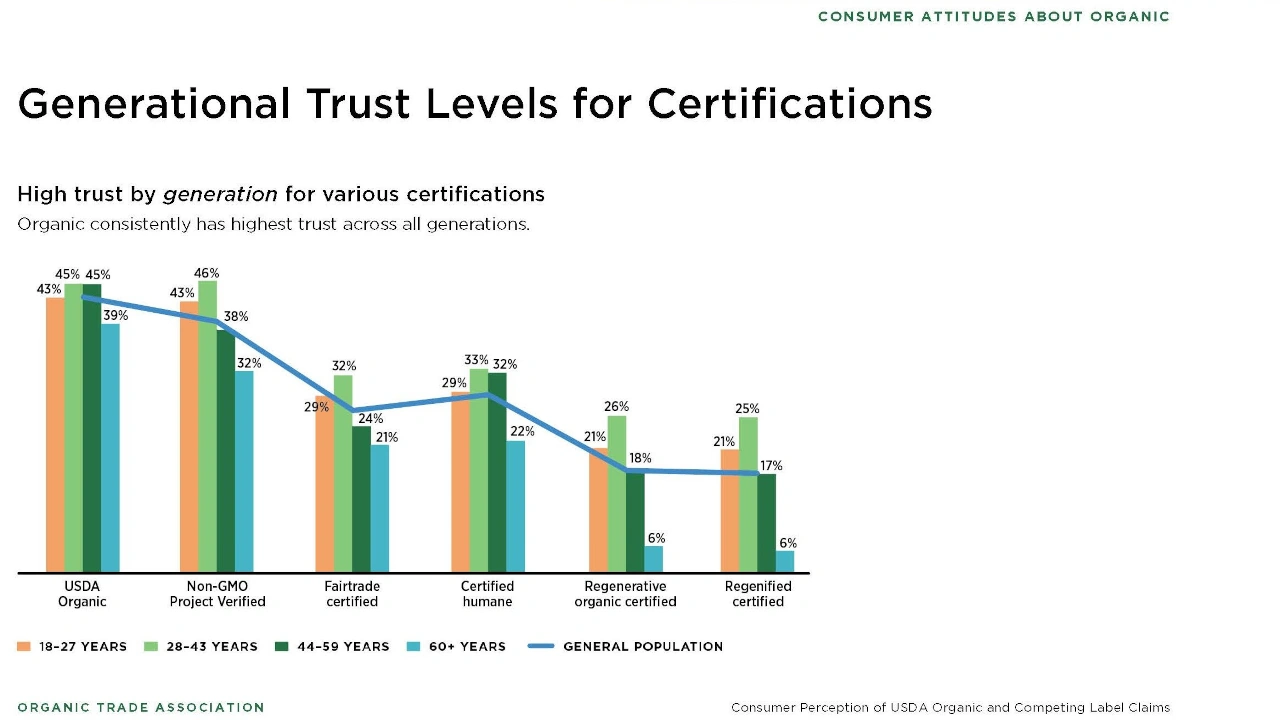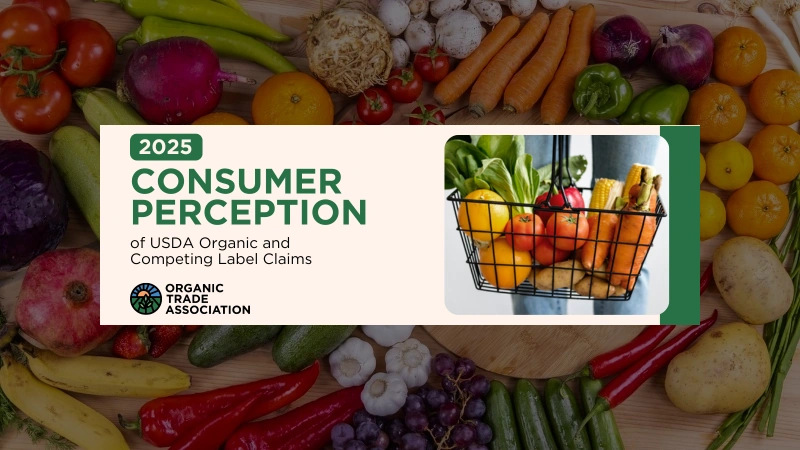Millennials, Gen Z putting high value on organic’s health benefits
A $70-billion market now, organic may be maturing, but younger consumers -including new parents and their babies- are eating it up. A survey released by the Organic Trade Association (OTA) finds that organic’s benefits to personal health and nutrition are resonating deeply with Millennials and Gen Zer’s, making them the most committed organic consumers of any generation.
In its new “Consumer Perception of USDA Organic and Competing Label Claims,” OTA partnered with Euromonitor International to survey over 2,500 consumers across the country in October 2024. Survey participants were asked about their familiarity with organic and other food label claims, their priorities in making food choices, how often they bought organic, and how willing they were to pay a premium for the organic label.
The results showed that not only do members of the Millennial and Gen Z generations buy the most organic, but that the USDA Organic label garners the deepest trust from consumers of all ages and is synonymous with health in the minds of most shoppers. Organic’s benefits to personal health outrank its benefits to environmental health in purchase decisions, especially with younger consumers, and the sometimes-higher prices of organic products are not an obstacle to those health-conscious individuals.

While older demographics may worry about the affordability of organic, the younger consumer – at every income level — is more willing to pay a premium for organic. The Gen Z generation (those between the ages of 13 and 28) in particular is leading the way in prioritizing organic, with nearly 90 percent of consumers surveyed in that age group already either a committed or relatively new consumer of organic. As this generation matures, has families, and advances professionally, all signs point to the Gen Zer’s being the drivers of organic into the future.
“There’s lots of good news in this report: younger consumers are embracing organic; consumers of all ages value the Organic label more than any other food label or claim,” said Tom Chapman, Co-CEO of the OTA. “The challenge to the organic sector is to demonstrate the distinct value of the USDA Organic label and break through the noise of all the other health, nutrition and sustainability claims in the marketplace.”
“Free from” and health-first
Consumers surveyed want their food to be clean and safe. That means free from toxic pesticides and chemicals, free from GMO’s, and produced without synthetic hormones and the heavy use of antibiotics. When sorting through the multitude of labels and claims in the grocery aisles, the survey found that while the big labels like organic, natural and local are familiar to today’s shopper, the “free from” or single attribute claims like no added hormones and raised without antibiotics carry greater weight in what finally lands in the shopping cart.
The sticking point here for organic, according to the survey findings, is that shoppers frequently do not realize that organic certification inherently meets all these “free-from” expectations. The USDA Organic label is backed up by strict government standards that ban the use of toxic pesticides and synthetic nitrogen fertilizers, antibiotics, synthetic hormones, and GMO’s. The survey results showed there is an untapped opportunity to more clearly inform consumers, especially the younger ones, about the full scope of what that Organic label stands for.
“This latest survey shows a great opportunity for organic,” said Matthew Dillon, Co-CEO of OTA. “Today’s younger consumers who are driving organic’s growth pay close attention to claims and want to know more about the products they’re buying. At times they don’t realize that organic encompasses the single attribute claims they value, like no antibiotics or growth hormones. We have an opening here to educate consumers, about the broad sweep of value and the attributes organic offers.”
Another revealing finding was that claims tied to the health and nutritional benefits of organic are more important to younger consumers in their purchasing decisions than broader environmental claims. That said, the survey shows that a consumer shift could be beginning, with younger generations increasingly considering the social and environmental impacts of their buying patterns. So, while the “secondary” environmental benefits of organic may not yet tip the scales for organic, it is a key part of the organic promise.
Regenerative claim not yet clearly understood or valued
The survey looked at 11 different food and beverage claims and certifications to see how organic stacked up. The food and beverage claims included in the survey were organic, natural, local, raised without antibiotics, non-GMO, no added hormones, free range, pasture raised, humanely raised, fair trade and regenerative.
Organic, local and natural were the claims consumers said they knew the best, with 90 percent of those surveyed familiar with organic. The regenerative claim, while increasingly part of the food industry lexicon, does not appear to have hit home yet with most consumers. Over 40 percent of consumers surveyed said they were unsure about what regenerative means, only about 25 percent found the regenerative claim important, and only 10 percent said they are willing to pay more for a product labeled regenerative.
Careful choices by young minds
Younger generations are reading the labels of their food closely. OTA’s survey found that food claims like organic, vegan and allergen-free are almost 40 percent more important to Millennials and Gen Zer’s than to older generations.
The USDA Organic label is particularly important for younger consumers, with over two-thirds seeking out the organic label in almost every food purchase. The Organic label was most valued in fresh food categories like fruits, vegetables, meat/poultry, baby food, eggs and dairy, and these items were the most likely products to be purchased as organic over the last 12 months.
More than half of U.S. consumers bought an organic fruit or vegetable in the last year. Consumers surveyed bought more bread in the last 6 months than any other food item, and 27 percent said they chose organic bread. For those surveyed consumers buying baby food, a whopping 93 percent chose organic.
“In just a little over two decades, the USDA Organic label has earned deep trust among consumers and has become one of the most identifiable food labels in our grocery stores,” said OTA’s Dillon. “The Gen Z consumer is now making its presence known, and this survey shows it puts a high value on organic. By continuing to reach out to this generation, and to all consumers, organic can establish a foundation for sustained growth across future generations.”
About the Organic Trade Association
The Organic Trade Association (OTA) is the membership-based business association for organic agriculture and products in North America. OTA is the leading voice for the organic trade in the United States, representing organic businesses and producers across the nation. Its members include growers, shippers, processors, certifiers, farmers’ associations, distributors, importers, exporters, consultants, brands. retailers and others. OTA’s mission is to promote and protect ORGANIC with a unifying voice that serves and engages its diverse members from farm to marketplace.




